Treatment of the knee joint is not a quick process and it is not always possible to get rid of the pain immediately. They often occur due to the destruction and deformation of cartilage tissue, but there may be other reasons. It is impossible to delay therapy, because joint diseases develop rapidly and can lead to serious consequences, even disability.
Causes of knee pain

The knee is an organ where the kneecap is joined by two bones. The cup, located in front of the knee, is connected to the tendons of the quadriceps muscle by ligaments. The bones are covered with cartilage, and between them are the cartilages of the moon - the meniscus. There are also several synovial fluid bags in the knee, which also act as a lubricant for the knee.
All this complex mechanism is designed to bend, stretch and absorb shock during movement. Any violation of his work causes anxiety and pain. How to treat the knee should be determined by a traumatologist after diagnosis.
The causes of pain can be very different, from fatigue and extreme stress to serious illnesses, and they are divided as follows:
- Knee injuries - all mechanical injuries can be attributed to such causes. Bruises, rupture of ligaments, bleeding into the joint cavity with intra-articular fractures, damage and rupture of the meniscus, dislocation of the patella. Such causes are usually characterized by acute localized pain, severe swelling, bruising, and difficulty or inability to move the joint.
- Inflammatory and degenerative joint diseases are the most common cause of knee pain in the elderly and the elderly. Arthritis, osteoarthritis, chondropathy, bursitis, Schlatter's disease and other diseases. It is characterized by increased pain or simply discomfort while moving, clicking during knee flexion / extension, pathological joint elasticity, and chronic knee instability.
- Various systemic infectious and viral diseases also cause inflammation and pain. These include osteoporosis, bone tuberculosis, syphilis, osteomyelitis and many others. This type of pain can be of a different nature depending on the inflammation of the body damaged by viruses and infections.
- Diseases in which pain spreads to the knees. Damage to the sciatic nerve, osteoarthritis of the hip joints, fibromyalgia. Such pains are a side effect, so they are periodically painful or feverish. In such cases, treatment of the knee joint will not bring relief.
Diagnosis and finding the cause of the pain will determine how the knee joint is treated. When symptoms of unknown origin appear, it is better not to treat yourself.
knee treatment
Treatment of knee pain can be conservative or surgical. Surgery is an operation performed to remove the cause of pain. Conservative therapy is a set of techniques aimed at relieving symptoms and pathologies. What is the treatment for knee pain?
Surgical methods
Such methods can be prescribed for severe injuries and inflammatory and degenerative diseases. Acute pain in the joints may indicate severe injuries or complete erosion of the cartilage. Therefore, several types of surgery are used.
Arthroscopy
Such an operation can be performed both for the diagnosis and treatment of severe joint injuries. Arthroscopes are inserted into the knee through micro-incisions, one of which is equipped with a camera and displays an "image" on the screen, and the other is intended for manipulation within the joint, mainly for treatment.
Such an operation significantly reduces the duration of postoperative and rehabilitation, in addition, practically does not leave scars. With the help of an arthroscope, torn ligaments and menisci are operated on. It is sometimes used to treat osteoarthritis, but its effectiveness in this situation is still in doubt.

Osteotomy
The most radical method With such an operation, the knee joint is completely opened, the patella is removed with the help of incisions, which allows you to manipulate it directly in the cavity. This method is also called open. Braces are usually placed on the bones, which helps to reduce the load on the joints.
A major disadvantage of such an operation is a long rehabilitation period. The patient will be able to walk after 1-2 months, and lead an active lifestyle only after a year. However, such an operation usually guarantees a long remission.
You should know that osteotomy is used in case of severe damage or deformation of the connective tissue, when partial removal of the diseased element is required.
Endoprostheses
All other treatments are performed when the joint is exhausted and continues to collapse together and ceases to perform its functions completely. After the affected element is completely removed by osteotomy, a knee implant is placed. It can be transplanted from a donor or replaced with an artificial prosthesis. They are made of plastic, ceramic or metal alloys.
In this way, the disease disappears completely and the patient achieves permanent remission. However, it is worth noting that the prosthesis can be rejected and other side effects are possible. Israel remains a leader in arthroplasty.

For reference! In most cases, knee pain is treated with milder methods. And such therapy is very effective and, most importantly, allows you to maintain an active lifestyle during rehabilitation.
Conservative treatment methods
Such methods are a set of techniques aimed at the restoration, healing and rehabilitation of joints. This includes drug treatment, physiotherapy exercises and gymnastics, physiotherapy. In some cases, folk methods may be included. In the first manifestations of knee pain, it is worth choosing a knee orthosis or braces that will slow down the destruction of tissue and reduce the symptoms of the disease before starting the main treatment.
Drug treatment
What to do first with knee pain? Of course, use painkillers and analgesics. Such funds can be in various pharmacological forms. Ointments and tablets are recommended for dull and aching pains. For acute and feverish, it is better to resort to injections that will immediately relieve pain.
Non-steroidal medications may be prescribed after diagnosis. Injuries, severe osteoarthritis and other degenerative diseases often cause the knee to swell. This medication is for this. They improve blood circulation, reduce inflammation and relieve pain.

The final stage of drug treatment will be the administration of chondroprotectors. They are prescribed for absolutely any injury and change in cartilage tissue. This is the basis of conservative treatment.
Fact! Chondroprotectors, like bricks, restore cartilage. They have properties to restore and restore elasticity.
However, it is worth preparing for the fact that treatment with chondroprotectors will be very long. The course lasts from three months to a year. The pharmacological form can be in the form of tablets, ointments and injections. By the way, such substances can also be found in food, so doctors recommend eating jelly, meat broth, avocado and jelly for pain in the knees.
In some cases, intramuscular injections of hyaluronic acid may be prescribed. It is a substance that is part of the synovial fluid that fills the joint cavity. This will help the connective tissue to regenerate and recovery will occur faster.
Exercise therapy and gymnastics
This is the most important stage both after surgery and medication. Physiotherapy should be done to prevent pain. For the proper implementation of the training complex, it should be conducted in a special center or sanatorium under the supervision of a rehabilitation therapist. It usually takes 2-3 months.
With its help, the knee joint gradually returns to active life, increasing the range of motion. Swimming will be the most important element. This will not only allow the joint to move smoothly, but also improve blood circulation and metabolism, which has a positive effect on tissue repair.
Physiotherapy
Such procedures are aimed at safe recovery and treatment. These methods give the best results with the least stress. These include the following methods:
- ultrasound therapy;
- electrophoresis;
- infrared therapy;
- various warming.
If your knee hurts a lot, how else can you treat your feet? Massage is also a good physical therapy, increases blood flow and speeds up the recovery process. Massage relieves pain well, as well as has a general strengthening effect.
Topical medications can be used without a doctor's prescription, and such treatment is acceptable for knee pain. But most likely, it will only eliminate the symptoms and cause them, and sooner or later it will cause anxiety again.
Folk remedies
Probably every patient who suffers from this disease knows how to treat knee pain with folk remedies:
- The first way will be to warm the joint. This can be done at home with the help of special compresses consisting of vodka and honey.
- You can visit a bath or sauna, which has a good effect on the whole body.
- A very modern method of warming will be a warming orthosis in the battery. It is comfortable, convenient and does not require much effort. One session can relieve pain in just 20-30 minutes.
- Mud and algae bandages also have a good effect on the joints. In a short time, they can restore cartilage elasticity and improve blood circulation, which helps to better nourish the tissues.
It should be remembered that alternative methods will be ineffective in severe injuries and in the later stages of the disease. Therefore, any treatment at home should be discussed with your doctor.

Patient opinion on treatment methods
It is impossible to answer the question of how to treat the knee joint without determining the cause, because in this case, symptomatic treatment can make the disease chronic at an early stage. An integrated approach is always required, and patient feedback confirms this.
- Woman, 55 years old: "My knee has been in pain for a long time. I could not understand the cause, then I went to the doctor again, it turned out that I have osteoarthritis. They prescribed chondroprotectants, which allowed me. Forget the pain. With the help of exercise therapy. "
- A 35-year-old man said: "He suffered a severe knee injury - a meniscus rupture. The doctor he treated prescribed arthroscopy and returned to the big sport after a short rehabilitation. "
- Male, 48 years old: "Unfortunately, arthrosis completely destroyed my joint, I did not pay attention to the pain for a long time. I had an endoprosthesis and a ceramic joint. I returned to active life and even started running in the morning. "
- Boy, 20 years old: "My sciatic nerve was constricted, I had dull pain in my knee. I could not understand the cause and rubbed the joint with non-steroidal ointments. Then I went to the doctor and found out that the pain was secondary and my knees were healthy. "





































